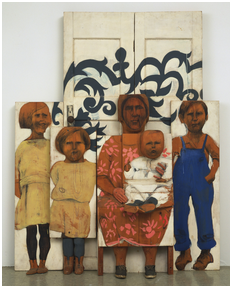Anglais Cycle 2
Day 3, April 7th
- Choisir un tableau parmi les 3 oeuvres proposées ci dessous
|
Edward Hopper, Lighthouse hill, 1927 |
Marisol, The Family,1963 |
|
Paul Klee, Le chat et l’oiseau, 1928 |
|
- Le décrire collectivement d’abord en français puis progressivement en anglais
- Utiliser le vocabulaire des champs lexicaux requis et proposer des phrases simples en s’appuyant sur les éléments de langage et les repères de progressivité ci après:
- Elaborer collectivement une trame de description de l’oeuvre (mots clé et phrases inscrites au tableau)
- Mémoriser d’abord collectivement puis individuellement certains mots, certaines phrases, et les noms des artistes ainsi que les oeuvres décrites
- S’entrainer à une première prise de parole continue en binômes ou en petits groupes.
- Mettre en scène cette prise de parole devant le groupe classe
|
– Shapes: square, rectangle, circle, triangle, line, Chinese signs… – Colours: velvet, brown…dark, light, pale… a soft light, blurred (flou), hazy (brumeux) – Characters & pets: man, woman, prince, king, princess, boy, girl, family, brother, sister, baby… – Landscape and scenery depiction (représentation): different points of view, different framings, different colours, different plans, sky line (ligne d’horizon) frame, tube, Watercolour painting, Seascape (marine sans bateau), a marine (marine avec bateau), horizon (l’horizon), lighthouse, hill, house, ship, sail, sea, ocean, storm, waves, cloud, dog – Clothes: dress, bathrobe, kimono, scarf, shoes, hat, suit (costume), a long dress, a hat with feathers, a stole (une étole) – Portraits: a full-face portrait, a profile portrait, a three-quarter portrait, a full portrait (en pied), a head and shoulders portrait (en buste) … – Objects: chair, table, carpet, door, house, table…furniture, leaf, leaves (feuille/feuilles), basket, ledge (corniche, rebord), flacon (pichet), Still life (nature morte), pewter(étain), fruit (apple, pineapple, grapes, melon, pear, cherry (rries) … – Adjectives: small, tall, thin, big, young, old, serious, nice, beautiful, ugly, … – Feelings: angry, sad, proud, happy, surprised, scared, … – Positions: on the right/left, at the top, in the bottom, in the background, on the forehand, next to, between behind, in front of… – Expression of opinion: I feel, I think, I chose, I don’t understand, I like/don’t like, I agree with you/don’t agree with you… – Actions and description: I can see, there is/are, standing, sitting, sleeping, smiling, looking….
|
![]()
Repères de progressivité et éléments de langage
|
A1 |
Exemples d’éléments de langage |
|
L’élève est capable de – S’appuyer sur les indices visuels pour identifier la nature du document et le thème central du support et pour comprendre partiellement la description physique des personnages |
All the pictures show a family / The artist shows families In the picture, we can see a mother, a little girl a boy and a baby The members of the family Dark clothes, bright colours, dull atmosphere Dirty clothes, a brown dress with a hole in Holding the baby in her arms, sitting down in the street, standing next to Some people in the street An umbrella, a basket of flowers |
|
L’élève est capable de – Repérer des informations isolées, ou répétées plusieurs fois – Comprendre l’atmosphère générale |
She looks unhappy, miserable The family is in difficulty, no money for food, love, sadness They look sad, feel sorry for… The general atmosphere, in the rain |
|
L’élève est capable de – Reconnaître quelques références culturelles visibles : rôle des couleurs et lien entre couleur et atmosphère |
The colours of the painting are all dark except… Bright colours, symbol of hope and love His clothes are dirty Dirty clothes, a brown dress with a hole in A long, black skirt, a brown cape, a black hat… |


